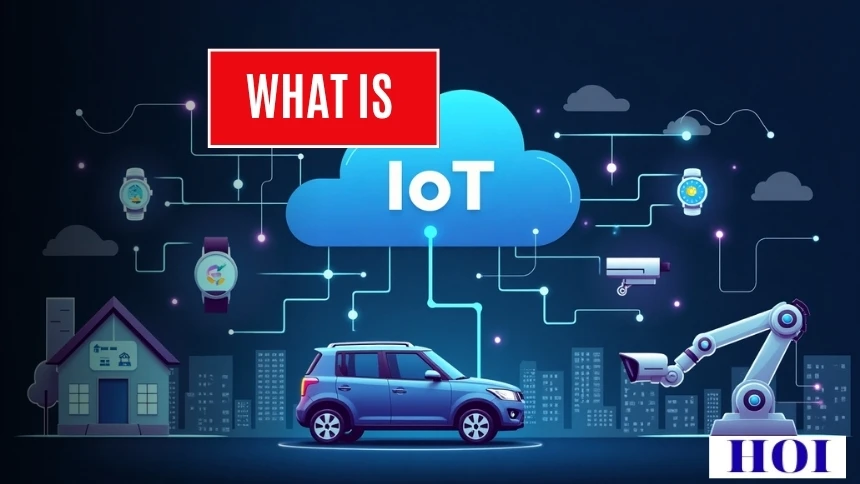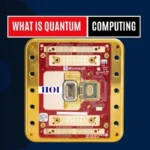What is IoT (Internet of Things)? Explained in Simple Words with Real-Life Examples
In today’s hyper-connected world, you might have heard the term IoT or Internet of Things. But what exactly is IoT, and why is it becoming such a big deal in our daily lives, homes, and even cities?
Let’s understand IoT in simple words, how it works, where it’s used, and how it’s silently reshaping the future — including yours.
What is IoT in Simple Words?
The Internet of Things (IoT) is a network of physical devices—like smartphones, smart TVs, refrigerators, cars, and even watches—that are connected to the internet and talk to each other without human involvement.
In simpler terms, IoT means “everyday objects getting smarter” by using the internet to send, receive, and process data.
Example: When your smart AC automatically turns on before you reach home, or your fitness band tracks your steps and updates it on your phone — that’s IoT in action.
How Does IoT Work?
IoT works by combining three core technologies:
- Sensors & Devices – Collect data (e.g., temperature, location, motion)
- Internet Connectivity – Transfers that data to the cloud or app
- Software/AI – Analyzes the data and triggers an action or report
Think of IoT as a system of “smart senses” and “smart brains” built into your gadgets.
Real-Life Examples of IoT Devices
Here are some common and practical IoT applications you may already be using or seeing:
| Category | IoT Example |
| Home | Smart bulbs (Philips Hue), Smart TVs, Alexa |
| Health | Fitness trackers, Smartwatches |
| Cars | Connected vehicles with GPS & real-time updates |
| Industry | Smart manufacturing machines |
| Agriculture | Sensors for soil moisture, irrigation control |
| Cities | Smart traffic lights, pollution monitoring |
Why is IoT Important?
IoT is not just about convenience — it’s about making systems more efficient, secure, and data-driven.
- In healthcare, IoT devices help track patient vitals in real-time
- In agriculture, farmers use IoT to automate irrigation
- In cities, IoT helps monitor air quality, traffic, and waste management
The more devices that connect, the smarter our world becomes.
IoT in India: A Growing Tech Frontier
India is quickly becoming an IoT hub, with smart cities like Delhi, Pune, and Bengaluru adopting IoT-based traffic and security systems. Indian startups are also building IoT solutions for:
- Smart farming
- Water conservation
- Industrial automation
The government’s “Digital India” initiative is boosting the adoption of IoT across sectors.
What are the Benefits of IoT?
- Automation: Devices can act on their own (e.g., smart thermostats)
- Time-Saving: No manual operations needed
- Cost-Effective: Optimizes resource usage (like electricity, water)
- Data Insights: Continuous monitoring and analysis for better decisions
- Safety & Security: Smart cameras, home locks, etc.
What Technologies Power IoT?
IoT is built using:
- 5G / Wi-Fi / Bluetooth for connectivity
- Cloud Computing for storage
- AI & Machine Learning for analysis
- Embedded Systems like Raspberry Pi, Arduino
- IoT Protocols like MQTT, CoAP, Zigbee
Is IoT Secure?
One major challenge with IoT is data privacy and security. Since IoT devices constantly collect and share data, they are often targeted by hackers.
That’s why companies now use:
- End-to-end encryption
- Regular software updates
- Strong authentication methods
Security is improving — but users also need to be aware.
What is the Future of IoT?
The future of IoT is massive. Experts predict over 25 billion IoT devices by 2030.
Emerging areas include:
- IoT + AI (AIoT): Smarter automation
- IoT in Smart Cities: Integrated transport, waste, energy systems
- IoT in Healthcare: Remote surgeries, elderly care
- IoT in Retail: Real-time inventory and customer tracking
The future is connected — and IoT will be the backbone of it.
FAQs
Q1: What is the full form of IoT?
A: IoT stands for Internet of Things.
Q2: Is IoT only for smart homes?
A: No, IoT is used in industries, agriculture, cities, health, retail, and more.
Q3: What language is used in IoT development?
A: Popular languages include Python, C, C++, JavaScript, and Node.js.
Q4: Are IoT devices always online?
A: Most are designed to be always connected to enable real-time communication.
Conclusion
So, what is IoT? It’s the technology that connects devices, people, and systems in ways we couldn’t imagine a decade ago. From turning on your light with your voice to managing entire city infrastructures — IoT is changing how the world works.
Whether you’re a student, entrepreneur, or tech lover — understanding IoT today means being prepared for tomorrow.





